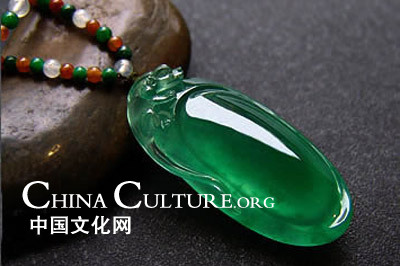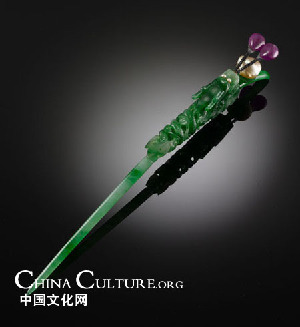Specials
Shining in its own style
Updated: 2008-11-07 16:56
(chinaculture.org)
For centuries Asian rulers and the wider society has had a devoted attachment to the luxurious green stone that is jade.
Jadeite, a kind of pyroxene with a degree of hardness, found mainly in Burma was popularly used in the Qing dynasty (1644-1911).
 |
|
|
In olden times, all men of the upper class wore personal ornaments of jade. Jade artifacts are, in fact, an important part of Chinese culture.
Jadeite, the most valued member of the jade family, became popular in China shortly after it was imported from Myanmar in the early Qing Dynasty (1644–1911). Because of its physical qualities, jade, jadeite in particular, suits the artistic and intellectual tastes of the Chinese people. The Chinese are reserved and mild. In their eyes, westerners are straight forward and aggressive, quite like the diamond.
|
|
Since 2950 BC, jade has been treasured in China as the royal gemstone, yu; the word yu is used in Chinese to call something precious. Jade was thought to preserve the body after death and can be found in emperors' tombs dating back thousands of years ago.
In addition jade was a symbol of love and virtue as well as a status symbol.
Gold may have a price, but jade is priceless
Testifying to how much the Chinese are fond of jade is this time-honored proverb: “Gold may have a price, but jade is priceless.” The value of gold can be determined by measuring its weight. Not jade. The value of a piece of jade or a jade artifact is “assessed” by taking numerous factors into account. For example, the purity and color, the sound it produces when struck, and when the jade piece was discovered or when a jade artifact was produced all contribute to affect a piece’s value.
Jade is rare with beautiful natural colors and it is difficult to find and to mine. Furthermore it is hard and difficult to process. That is why jade is regarded as gemstone alongside diamond, ruby, sapphire and emerald.
|
|
All over the world there are very few places that produce jade. Jade stones are formed over long geographical epoch. In ancient times Chinese people went to the mountains or riverbed to try their luck to look for jade. After thousands of years’ exploitation, high quality jade stones have almost become depleted.
Jade is hard, especially jadeite is with solid texture with the hardness of degree 6 or above. (on the basis of the hardness of diamond is 10) Today man-made diamonds can be very close to the quality of natural ones. However, jade stones can not be man-made like natural ones. Imperial green that is translucent is very rare, and a bracelet that is all imperial jade color will cost at least $100,000 as a starting price.
In terms of quality jade artifacts are classified into three grades, A, B and C. Those of Grade A largely retain their natural features despite their processing, cutting and engraving. Products of Grade B products however are bleached to get rid of impurities. Grade C products are often dyed and therefore of little value.
It is difficult for the layman to distinguish good jade from bad jade, not to mention other physical qualities of the stone.
Jadeite's color commonly ranges from white through pale apple green to deep jade green but can also be blue-green, pink, lavender, and a multitude of other rare colors. Color is largely affected by the presence of trace elements such as chromium and iron. Its translucence can be anywhere from entirely solid through opaque to almost clear. Variations in color and translucence are often found even within a single specimen.
Specials

'Super moon'
The "Super Moon" arrives at its closest point to the Earth in 2011.

Radiation test
The probability of being exposed to a life-threatening level of radiation is quite slim.

Panic buying of salt
Worried Chinese shoppers stripped stores of salt on radiation fears.

